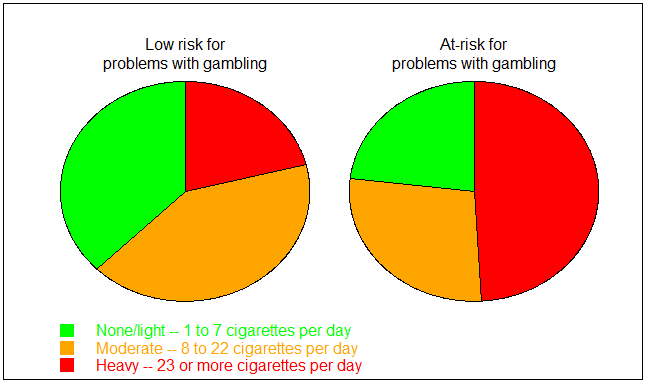Heavy smokers often report that they began smoking in adolescence. Likewise, people with gambling problems often report that they began gambling in adolescence. Researchers have begun to study possible links between smoking and gambling among teenagers. As part of our Special Series on Gambling and Addiction, this week’s ASHES reviews work by Andrea Weinberger and her colleagues, based on a survey of Connecticut high school students about their smoking and gambling.
What is the research question?
Are adolescents who are at-risk for gambling problems more likely to smoke more, and to start smoking at an earlier age, than other adolescents?
What did the researchers do?
Weinberger and her colleagues surveyed 4,523 Connecticut high school students[1]. Participants answered questions about their past smoking history and current smoking frequency. They also completed the Massachusetts Gambling Screen (MAGS). The researchers focused on the 236 participants who said they smoked regularly and gambled at least once in the past year., The researchers classified each of these participants as reporting either low-risk gambling (n = 128) or at-risk or problematic gambling (n = 108), based on their responses to the MAGS. The researchers used chi-square tests to compare the smoking histories and frequencies of the low risk and at-risk student groups.
What did they find?
Among the participants who reported smoking regularly, those who reported at-risk or problematic gambling were more likely to have become daily smokers earlier in life. They also tended to smoke more cigarettes per day (see Figure). Those at risk for problems with gambling were more likely to have tried to quit smoking at least once in the past.

Figure. Cigarette smoking among participants who reported smoking regularly and gambling at least once in the past year. The participants were separated into those with low risk for problems with gambling and those who were at-risk for problems with gambling. Adapted from Weinberger et al. (2015). Click image to enlarge.
Why do these findings matter?
These results suggest that the teens who could benefit the most from messages about the risks of smoking are the same teens who could benefit the most from messages about the risks of gambling. Currently, PSA campaigns like “Truth” tend to focus on a single product – cigarettes, alcohol, marijuana, gambling. Since all of these products appear to have overlapping customer bases, perhaps such campaigns ought to address multiple potential problems. It might work better than the current patchwork mix used today.
Every study has limitations. What about this one?
This study used self-reports of smoking and gambling histories, which could be inaccurate for a number of reasons. Prospective research that tracked the same set of teens over time could help us understand how these behaviors develop and how to intervene early, especially for kids who have risk factors for addiction.
For more information:
The National Center for Responsible Gambling has resources for raising awareness among youth about gambling disorder. The National Cancer Institute has a website called Smokefree Teen. It provides support for teens looking to quit smoking. For additional tools, please visit the BASIS Addiction Resources page.
— Matthew Tom
What do you think? Please use the comment link below to provide feedback on this article.
________________
[1] Of the 4,523 participants, 44.9% reported past-year gambling and responded to the survey questions on gambling behavior, and 19.0% reported smoking regularly.




